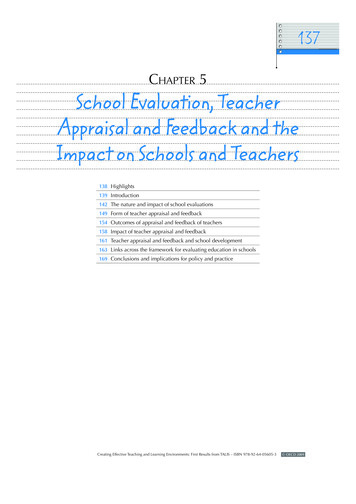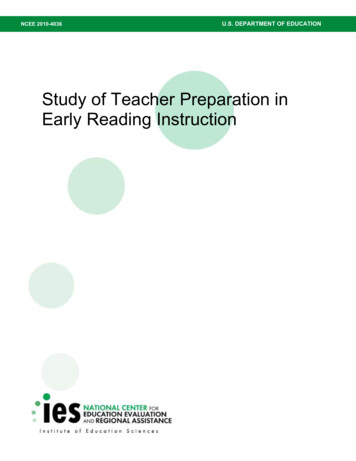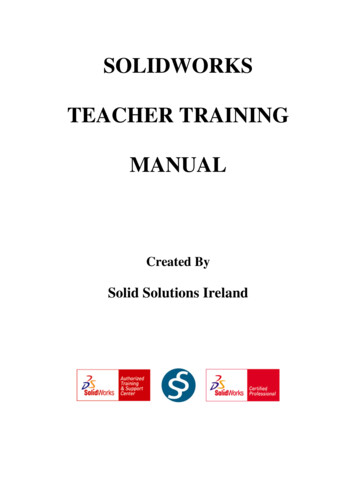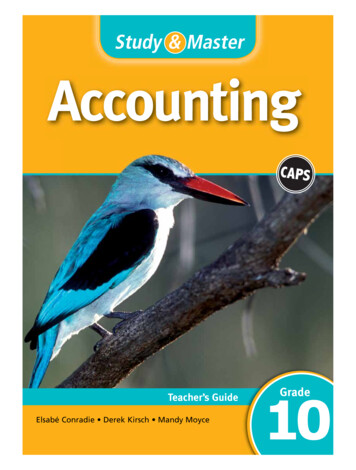
Transcription
137CHAPTER 5School Evaluation, TeacherAppraisal and Feedback and theImpact on Schools and Teachers138 Highlights139 Introduction142 The nature and impact of school evaluations149 Form of teacher appraisal and feedback154 Outcomes of appraisal and feedback of teachers158 Impact of teacher appraisal and feedback161 Teacher appraisal and feedback and school development163 Links across the framework for evaluating education in schools169 Conclusions and implications for policy and practiceCreating Effective Teaching and Learning Environments: First Results from TALIS – ISBN 978-92-64-05605-3 OECD 2009
138CHAPTER 5 SCHOOL EVALUATION, TEACHER APPRAISAL AND FEEDBACK AND THE IMPACT ON SCHOOLS AND TEACHERSHighlights Appraisal and feedback have a strong positive influence on teachers and theirwork. Teachers report that it increases their job satisfaction and, to some degree,their job security, and it significantly increases their development as teachers. The greater the emphasis on specific aspects of teacher appraisal and feedback,the greater the change in teachers’ practices to improve their teaching. In someinstances, more emphasis in school evaluations on certain aspects of teachingis linked to an emphasis on these aspects in teacher appraisal and feedbackwhich, in turn, leads to further changes in teachers’ reported teaching practices.In these instances, the framework for the evaluation of education appears to beoperating effectively. A number of countries have a relatively weak evaluation structure and do notbenefit from school evaluations and teacher appraisal and feedback. For example,one-third or more of teachers work in schools in Austria (35%), Ireland (39%)and Portugal (33%) that had no school evaluation in the previous five years. Inaddition, on average across TALIS countries, 13% of teachers did not receive anyappraisal or feedback in their school. Large proportions of teachers are missingout on the benefits of appraisal and feedback in Italy (55%), Portugal (26%), andSpain (46%). Most teachers work in schools that offer no rewards or recognition for theirefforts. Three-quarters reported that they would receive no recognition forimproving the quality of their work. A similar proportion reported they wouldreceive no recognition for being more innovative in their teaching. This says littlefor a number of countries’ efforts to promote schools as centres of learning thatfoster continual improvements. Most teachers work in schools that do not reward effective teachers and do notdismiss teachers who perform poorly. Three-quarters of teachers reported that,in their schools, the most effective teachers do not receive the most recognition.A similar proportion reported that, in their schools, teachers would not bedismissed because of sustained poor performance. OECD 2009Creating Effective Teaching and Learning Environments: First Results from TALIS – ISBN 978-92-64-05605-3
139SCHOOL EVALUATION, TEACHER APPRAISAL AND FEEDBACK AND THE IMPACT ON SCHOOLS AND TEACHERS CHAPTER 5INTRODUCTIONThe framework for evaluation of education in schools and for appraisal and feedback of teachers are key TALISconcerns. Evaluation can play a key role in school improvement and teacher development (OECD, 2005).Identifying strengths and weaknesses, making informed resource allocation decisions, and motivating actors toimprove performance can help achieve policy objectives such as school improvement, school accountabilityand school choice. Data were collected from school principals and teachers on these and related issues,including the recognition and rewards that teachers receive. Analysis of the data has produced a number ofimportant findings for all stakeholders.Data from teachers and school principals show that school evaluations can affect the nature and form of teacherappraisal and feedback which can, in turn, affect what teachers do in the classroom. An opportunity thereforeexists for policy makers and administrators to shape the framework of evaluation to raise performance and totarget specific areas of school education. In particular, TALIS data indicate that opportunities exist to betteraddress teachers’ needs for improving their teaching in the areas of teaching students with special learningneeds and teaching in a multicultural setting (see also Chapter 3).In addition, teachers report that the current framework for evaluation lacks the necessary support andincentives for their development and that of the education they provide to students. They report few rewardsfor improvements or innovations and indicate that in their school, the most effective teachers do not receivethe greatest recognition. Opportunities to strengthen the framework for evaluating school education in order toreap the benefits of evaluation therefore appear to exist in most, if not all, education systems. Teachers reportthat the appraisal and feedback they receive is beneficial, fair and helpful for their development as teachers.This provides further impetus to strengthen and better structure both school evaluations and teacher appraisaland feedback.The first section discusses the nature and impact of school evaluations across TALIS countries. It focuses onthe frequency of evaluation, particularly in countries where schools are rarely, if ever, evaluated, and onthe objectives of these evaluations. This is followed by a discussion of teacher appraisal and feedback withspecial attention to its frequency and focus. The outcomes and impacts of teachers’ appraisal and feedbackare then discussed in the following sections. Teacher appraisal and feedback in the broader context ofschool development is then analysed. The links between school evaluations, teacher appraisal and feedback,and impacts on teachers and their teaching are then discussed and concluding comments and key policyimplications are then presented.Analyses presented in this chapter (and throughout this report) and the discussion of the main findings aretempered somewhat by the nature of the TALIS data. It should be noted that, since TALIS is a cross-sectional study,it is not prudent to make sweeping causal conclusions, particularly about the impact on student performanceas this is not measured in the TALIS programme. Care must therefore be taken in interpreting results where thelong-term impact on student performance cannot be ascertained.Framework for evaluating education in schools: data collected in TALISThe role of school evaluation has changed in a number of countries in recent years. Historically, it focusedon monitoring schools to ensure adherence to procedures and policies and attended to administrative issues(OECD, 2008d). The focus in a number of countries has now shifted to aspects of school accountability andschool improvement. Moreover, in some systems, school performance measures and other school evaluationinformation are published to promote school choice (Plank and Smith, 2008; OECD, 2006a). An additionalfactor driving the development of the framework for evaluating education in schools, and of school evaluationin particular, is the recent increase in school autonomy in a number of educational systems (OECD, 2008a).Creating Effective Teaching and Learning Environments: First Results from TALIS – ISBN 978-92-64-05605-3 OECD 2009
140CHAPTER 5 SCHOOL EVALUATION, TEACHER APPRAISAL AND FEEDBACK AND THE IMPACT ON SCHOOLS AND TEACHERSA lessening of centralised control can lead to an increase in monitoring and evaluation to ensure adherenceto common standards (Caldwell, 2002). Moreover, greater school autonomy can lead to more variation inpractices as schools are able to choose and refine the practices that best suit their needs. Such variation, andits impact on performance, may need to be evaluated not only to ensure a positive impact on students andadherence to various policy and administrative requirements but also to learn more about effective practices forschool improvement. This is particularly important in view of the greater variation in outcomes and achievementamong schools in some education systems than in others (OECD, 2007; OECD, 2008a).School evaluation with a view to school improvement may focus on providing useful information for makingand monitoring improvements and can support school principals and teachers (van de Grift and Houtveen,2006). Appraisal of teachers and subsequent feedback can also help stakeholders to improve schools throughmore informed decision making (OECD, 2005). Such improvement efforts can be driven by objectives thatconsider schools as learning organisations which use evaluation to analyse the relationships between inputs,processes and, to some extent, outputs in order to develop practices that build on identified strengths andaddress weaknesses that can facilitate improvement efforts (Caldwell and Spinks, 1998).Holding agents accountable for public resources invested and the services provided with such resources isan expanding feature of Government reform in a number of countries (e.g. Atkinson, 2005; Dixit, 2002; Manteand O’Brien, 2002). School accountability, which often focuses on measures of school performance, can bean aspect of this accountability and can drive the development of school evaluations (Mckewen, 1995).School accountability can also be part of a broader form of political accountability which holds policy makersaccountable through the evaluation of their decision-making and market-based accountability that focuses onthe public evaluating different uses of public resources (Ladd and Figlio, 2008). School accountability mayalso be an important element of standards-based reforms which emphasise standards in teaching practices orthe entire school education system. The framework for evaluating education in schools can also be used todrive efforts aimed at teacher accountability. Recently, such reforms have tended to concentrate on studentperformance standards (Bourque, 2005). School evaluations and teacher appraisal and feedback can focus onsuch standards, the extent to which they are met, and the methods employed to reach, meet, or exceed them.Identifying and setting standards can also have implications for teachers’ professional development, which, inturn, can be oriented to help teachers to better achieve them (OECD, 2005).When families are free to choose among various schools, school choice can be an important focus of the evaluationof school education. Information about schools helps parents and families decide which school is likely to bestmeet their child’s needs (Glenn and de Groof, 2005). Improved decision-making can increase the effectivenessof the school system as the education offered by diverse schools is better matched to the diverse needs of parentsand families if they are free and able to choose between schools (Hoxby, 2003). The effects of more informedschool choice depend upon factors such as the type of information available and parents’ and families’ access tothat information (Gorard, Fitz and Taylor, 2001). In some education systems, the results of school evaluations aretherefore made available to the public to drive school accountability and improve school choice. For example, inBelgium (Fl.), current information on school evaluations is available on a central website and earlier school reportscan be requested by families that are choosing a school for their child (OECD, 2008a).Data collected in TALISFigure 5.1 depicts the framework for evaluating education in schools and the main areas on which data fromteachers and school principals were collected. It reflects previous research on the role of evaluation in thedevelopment of schools and teachers and on the design of such evaluations to meet education objectives(OECD, 2008d; Sammons et al., 1994; Smith and O’Day, 1991). This framework often begins with directionfrom the central administrative and policy-making body (Webster, 2005; Caldwell, 2002). In most education OECD 2009Creating Effective Teaching and Learning Environments: First Results from TALIS – ISBN 978-92-64-05605-3
141SCHOOL EVALUATION, TEACHER APPRAISAL AND FEEDBACK AND THE IMPACT ON SCHOOLS AND TEACHERS CHAPTER 5systems it is the Government Ministry responsible for school education that sets regulatory and proceduralrequirements for schools and teachers. Policy makers may set performance standards and implement specificmeasures which should be, along with other factors, the focus of school evaluations (Ladd, 2007). These mayinclude student performance standards and objectives, school standards, and the effective implementation ofparticular programmes and policies (Hanushek and Raymond, 2004). A focus on a specific aspect of evaluation,such as teacher appraisal and feedback, may have a flow-on effect on the school and its practices, as teachersare the main actors in achieving school improvement and better student performance (O’Day, 2002). However,for evaluations to be effective their objectives should be aligned with the objectives and incentives of those whoare evaluated (Lazear, 2000). To the extent that evaluations of organisations and appraisals of employees createincentives, the evaluations and appraisals need to be aligned so that employees have the incentive to focustheir efforts on factors important to the organisation (OECD, 2008d). The extent of this effect can depend on thefocus in the school evaluation and the potential impact upon schools (Odden & Busch, 1998). It may also affectthe extent to which teacher appraisal and feedback is emphasised within schools (Senge, 2000). However, it isimportant to recognise that TALIS does not collect information about the objectives, regulations and proceduresdeveloped and stated by policy makers in each education system. Data collected in TALIS are at the school andteacher level from school principals and teachers and therefore focus on the final three aspects of the evaluativeframework of school education depicted in Figure 5.1.TALIS collected data on school evaluations from school principals. The data include the frequency of schoolevaluations, including school self-evaluations, and the importance placed upon various areas. Data werealso obtained on the impacts and outcomes of school evaluations, with a focus on the extent to which theseoutcomes affect the school principal and the school’s teachers. TALIS also collected data from teachers on thefocus and outcomes of teacher appraisal and feedback. This information makes it possible to see the extent towhich the focus of school evaluations is reflected in teacher appraisal and feedback.Both school evaluation and teacher appraisal and feedback should aim to influence the development andimprovement of schools and teachers. Even a framework for evaluation based on regulations and proceduralrequirements would focus on maintaining standards that ensure an identified level of quality of education.TALIS therefore collected information on changes in teaching practices and other aspects of school educationsubsequent to teacher appraisal and feedback. According to the model depicted in Figure 5.1, a focus in schoolevaluations on specific areas which reflect stated policy priorities should also be a focus of teacher appraisal andfeedback. This should in turn affect practices in those areas. Considering that TALIS does not collect informationon student outcomes, teachers’ reports of changes in teaching practices are used to assess the impact of theframework of evaluation. In addition, teachers’ reports of their development needs provide further informationon the relevance and impact of this framework on teachers’ development.Data were also collected from teachers on the role of appraisal and feedback in relation to rewards andrecognition within schools. The focus on factors associated with school improvement and teachers’ developmentincluded teachers’ perceptions of the recognition and rewards obtained for their effectiveness and innovationin teaching.In gathering data in TALIS, the following definitions were applied: School evaluation refers to an evaluation of the whole school rather than of individual subjects ordepartments. Teacher appraisal and feedback occurs when a teacher’s work is reviewed by either the school principal, anexternal inspector or the teacher’s colleagues. This appraisal can be conducted in ways ranging from a moreformal, objective approach (e.g. as part of a formal performance management system, involving set proceduresand criteria) to a more informal, more subjective approach (e.g. informal discussions with the teacher).Creating Effective Teaching and Learning Environments: First Results from TALIS – ISBN 978-92-64-05605-3 OECD 2009
142CHAPTER 5 SCHOOL EVALUATION, TEACHER APPRAISAL AND FEEDBACK AND THE IMPACT ON SCHOOLS AND TEACHERSFigure 5.1Structure for evaluation of education in schools: data collected in TALISCentral objectives, policies and programmes, and regulations developedby policy makers and administratorsSchool and teacherobjectives and standardsStudent objectivesand standardsRegulations andproceduresSchool evaluations(Principal questionnaire)Criteria and focus(Principal questionnaire)Impact and outcomes(Principal questionnaire)Teacher appraisal and feedback(Teacher questionnaire and Principal questionnaire)Criteria and focus(Teacher questionnaireand principal questionnaire)Impact and outcomes(Teacher questionnaireand principal questionnaire)School and teacher development and improvement(Teacher questionnaire)Source: OECD.12 http://dx.doi.org/10.1787/607856444110NATURE AND IMPACT OF SCHOOL EVALUATIONSTALIS provides information on the frequency of school self-evaluations and external school evaluations (e.g. thoseconducted by a school inspector or an agent from a comparable institution) and on the areas covered by suchevaluations. School principals were asked to rate the importance of 17 items ranging from measures of studentperformance to student discipline and behaviour. Data were also obtained on the influence of evaluations uponimportant aspects which can affect schools and teachers, such as an impact on the school budget, performancefeedback, and teachers’ remuneration. In addition, data were obtained from school principals regarding thepublication of information on school evaluations.1Frequency of school evaluationsThe frequency of school evaluations provides an initial indication of both the breadth of the evaluation ofeducation in schools and the place of school evaluations in the framework of evaluation. Distinctions betweenexternal and internal evaluations identify the actors involved and the interaction between schools and a OECD 2009Creating Effective Teaching and Learning Environments: First Results from TALIS – ISBN 978-92-64-05605-3
143SCHOOL EVALUATION, TEACHER APPRAISAL AND FEEDBACK AND THE IMPACT ON SCHOOLS AND TEACHERS CHAPTER 5centralised decision-making body. As Table 5.1 shows, countries differ considerably in this respect. One-third ormore of teachers worked in schools whose school principal reported no internal or external school evaluationsin the previous five years in Austria (35%), Ireland (39%), and Portugal (33%). This also was the case for aroundone-quarter of teachers in Denmark and Spain and around one-fifth in Brazil, Bulgaria and Italy. Clearly, thesecountries have relatively little in the way of a framework for school evaluation. However, in Ireland and Italypolicies are being implemented to increase the frequency and reach of school evaluations but at the time of thesurvey these policies were not yet fully in place.In contrast, in a number of countries teachers worked in schools with at least one evaluation over the previousfive years. In Australia, Brazil, Bulgaria, Hungary, Italy, Korea, Lithuania, Malaysia, Malta, Mexico, Poland,the Slovak Republic, Slovenia and Turkey, at least half of teachers worked in schools whose school principalreported at least an annual school evaluation (either an external evaluati
improve performance can help ach ieve policy ob jectives such as school improvement, school accountab ility and school cho ice. Data were collected from school principals and teachers on these and related issues, includ ing the recogn ition and rewards that teache











